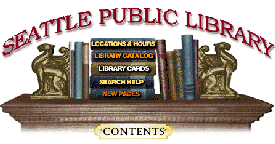Serving the Community

Over the last decade the library has been building a technical infrastructure that enables it to serve its public in new ways. The library has developed programs for specific populations, developed local electronic content, and formed partnerships with local agencies to meet specific goals. With the World Wide Web and computer laboratories, especially, the staff is reaching out to new groups.
Community Learning Labs bring technology to the public and provide facilities where groups may use electronic information together. The Rainier Beach branch was chosen as the site for a lab because there is strong community involvement with the branch library, an economically disadvantaged population of diverse ethnic composition lives in the neighborhood, and the branch library is within walking distance of three schools and a community center. An advisory committee of community members governs the use of this lab.
A second lab was established at the High Point branch in a public housing project. The lab is used heavily by children after school. Branch librarian Erica Sternin said that since the computers were installed, more people are using the building (40-50 children after school in two small rooms), and that there has been “a 55 per cent increase in the circulation of children’s materials over last year.” She described the delight of a young Somali girl, daughter of immigrant parents who do not yet speak English, who learned word processing and found information in the lab for a paper. The student earned an A-plus grade for the project from her teacher.
The Central Library Community Learning Lab has been used for group exploration of Internet resources and training. Librarians invite community organizations to the lab, provide instruction, and initiate dialogue. Their librarian colleagues observe the sessions, and in the process learn about teaching technique and how people want to use computers and electronic information. Groups have included preschoolers from three local Head Start centers, elementary-school-age children, and teenage African American males from a club established to build self-esteem.
With the expansion of online services, whether delivered at the library, home, school, office, or community center, individuals may seek information anonymously, on their own terms and for their own purposes. There have been many examples of successful use of the library’s online systems. For example, through the Internet, one user found a scholarship and a student loan forgiveness program just five weeks before the start of school. This enabled her sister, a public school teacher and a parent, to begin graduate studies. Although there are many uses for the Internet, its productive use by homeless citizens of Seattle has received a good deal of coverage in the local press. These citizens use the public access workstations to find information about job opportunities, practice computer skills, or communicate with new friends through e-mail. E-mail enables the correspondents to avoid some of the prejudices that a homeless person might encounter in face-to-face communication. Teenage boys from a local high school became sufficiently skilled that they helped the library staff install Internet workstations in at the central library.
Partnerships with other organizations have enabled the library to establish new services. The library secured a $84,647 federal LSCA grant to establish a self-service library facility and outreach program in the Southwest Youth and Family Services Center, located in the geographically isolated and previously unserved Delridge neighborhood. The area has a large population of senior citizens. Because of this service, the residents of Delridge now have two free public access workstations (one with World Wide Web capabilities) and the opportunity to borrow library materials from a convenient location. The library has used grant funds from the Microsoft Libraries Online! Project to leverage resources and cooperation from new partners: West Seattle High School and the TCI cable company. The resulting community learning lab provides services not only to students, but to the neighborhood as a whole. For example, the lab located within the school is opened to the public one night a week. A visionary principal and an eager high school librarian have helped the public library discover new ways to deliver information cooperatively.
The library has converted to electronic form its community information database called “Community Contacts.” The database describes thousands of local organizations and offers a subject index to the interests of each group. Two other organizations serve local information needs. The Seattle Community Network (SCN) is a Free-net (http://www.scn.org/), which provides e-mail services (Seattle Public Library does not) and community-generated content. The Free-Net uses office space at the Seattle Public Library, and Yvonne Chen, head of library reference services, is on the board of directors. A second network, the Seattle Public Access Network (PAN), provides local Seattle content online. PAN is a city-maintained web site (http://www.pan.ci.seattle.wa.us) with city-generated content. The library’s homepage points to SCN and PAN. The library cooperates with SCN and PAN to disseminate local information to people who need it, and to share computing facilities for large files.

